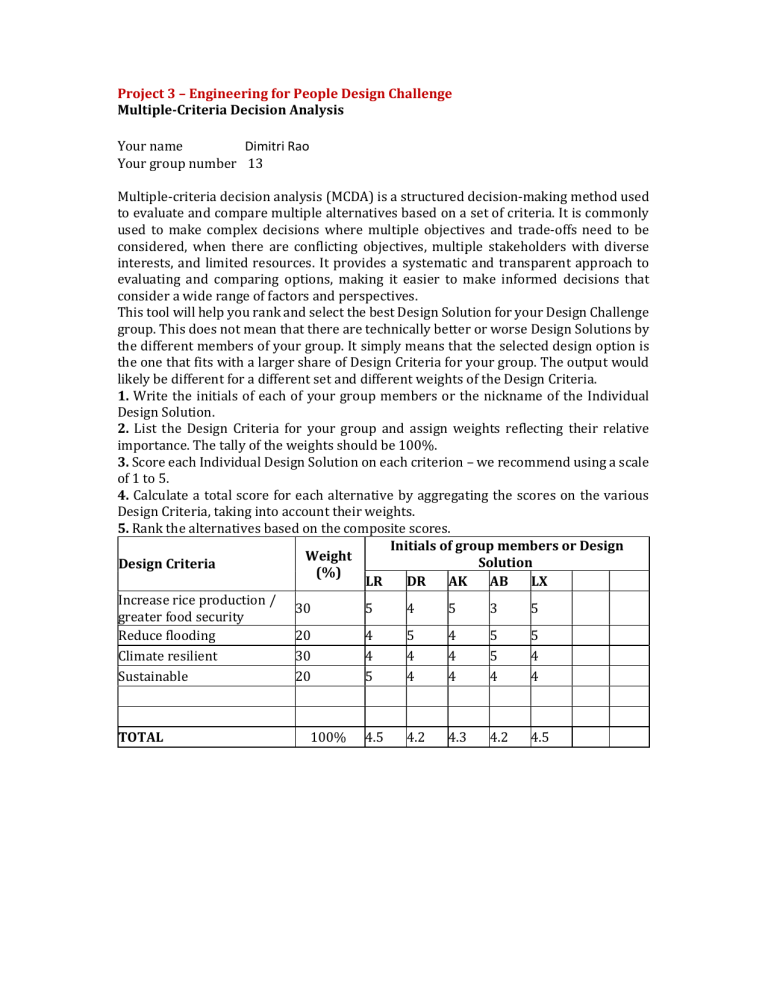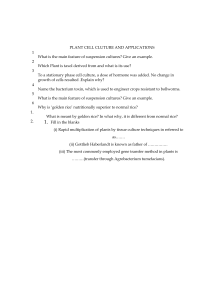
Project 3 – Engineering for People Design Challenge Multiple-Criteria Decision Analysis Your name Dimitri Rao Your group number 13 Multiple-criteria decision analysis (MCDA) is a structured decision-making method used to evaluate and compare multiple alternatives based on a set of criteria. It is commonly used to make complex decisions where multiple objectives and trade-offs need to be considered, when there are conflicting objectives, multiple stakeholders with diverse interests, and limited resources. It provides a systematic and transparent approach to evaluating and comparing options, making it easier to make informed decisions that consider a wide range of factors and perspectives. This tool will help you rank and select the best Design Solution for your Design Challenge group. This does not mean that there are technically better or worse Design Solutions by the different members of your group. It simply means that the selected design option is the one that fits with a larger share of Design Criteria for your group. The output would likely be different for a different set and different weights of the Design Criteria. 1. Write the initials of each of your group members or the nickname of the Individual Design Solution. 2. List the Design Criteria for your group and assign weights reflecting their relative importance. The tally of the weights should be 100%. 3. Score each Individual Design Solution on each criterion – we recommend using a scale of 1 to 5. 4. Calculate a total score for each alternative by aggregating the scores on the various Design Criteria, taking into account their weights. 5. Rank the alternatives based on the composite scores. Initials of group members or Design Weight Solution Design Criteria (%) LR DR AK AB LX Increase rice production / 30 5 4 5 3 5 greater food security Reduce flooding 20 4 5 4 5 5 Climate resilient 30 4 4 4 5 4 Sustainable 20 5 4 4 4 4 TOTAL 100% 4.5 4.2 4.3 4.2 4.5 Dimitri Rao – s2526155 Engineering Principles 1 Project 3 – Design Challenge Individual Design Solu on Dimitri Rao - Group 13 Dimitri Rao – s2526155 Exclusive Statement In Pu Ngaol, food produc on is a prominent issue for the locals and must be improved. One of the main products of food produc on in the village is rice, and rice farming is facing many opposing factors, the wet season is flooding the fields, and the dry season is drying out the crops. Therefore, new designs must be put in place to help rice produc on in both seasons to not only feed the village but also allow farmers to sell excess produce and make more income. Narra ve Descrip on Firstly, in the wet season, the rainfall in Cambodia is very heavy with Pu Ngaol receiving around 200mm of rain during the wet season. Therefore, the rice fields are easily flooded, and this damages the crops and the landscape. The first way to combat this is to redirect rainwater away from the village and fields. Using concrete gu ers (Figure 2), some of the water could be directed into the Ou Te River and reduce the flood risk on the rice fields. However, rain will s ll be a problem, so I propose for the villagers move to terraced farming (Figure 3) for the rice fields. This means that each small plot of rice is on its own step which is dug out of the mountain side. This has many benefits, the main ones being erosion control, water control and land u liza on. Because the soil is no longer at a slope, there is also a lot less soil erosion, so the risk of land slides is reduced. Pu Ngaol is in a very mountainous area of Cambodia meaning a lot of the land available to the locals is not accessible to farming. With terraced farming this land will be more u lised, and the locals can make more rice which can be used for consump on and selling. When plan ng the rice on the terraced farms, it allows them to make rice paddies (Figure 4). This is when the rice fields are flooded. This works hand in hand with terraced farming as it already naturally regulates water meaning the flooded fields will naturally be regulated. Furthermore, the water protects the crops from weeds and pests improving rice produc on. In the dry season, the flooded fields will also keep the crops cool and aid in growth. Terraced farming also naturally creates divides in land so plots can be easily recognisable, and it is clear to every villager which plot is whose and manging the plots will be easier. However, the main concern in the dry season is the lack of rain. So, during the wet season, the water collec on system will store rainwater to be used during the dry season to keep the rice well supplied. Water will be stored in small reservoirs (Figure 1) and large plas c (Figure 6) tanks that can be buried as to not damage the walls of the tank. This can be done with the locals transpor ng the water or using field sprayers to make the process less manual and aid the farmers. Furthermore, some of the water will be fed through an industrial water filtra on (Figure 5) unit which can be used as drinking water for the locals. Overall, these solu ons ensure that rice produc on in Pu Ngaol is improved. The terraced farms and gu ers reduce flooding of fields and the village, and the paddies help the rice grow in hot weather. Furthermore, this is sustainable as the only piece of machinery used is the water filtra on unit, the rest is natural. Dimitri Rao – s2526155 Diagrams and Photos Figure 1: Concrete water reservoir that will be located in the fields Figure 2: Path side gu ers that will lead water into the river Figure 3: Terraced farms on the side of a mountain Dimitri Rao – s2526155 Figure 4: Rice paddies: flooded field Figure 5: Water filtra on unit that will collect some of the water from the gu ers Figure 6: Plas c water tank that can be buried for protec on Dimitri Rao – s2526155 Figure 7: Field sprayer that can be carried by one farmer to spray rice Figure 8: Diagram of Terraced Farming

